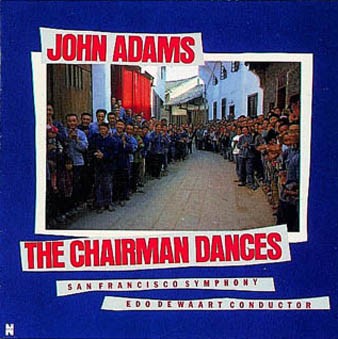San Francisco Symphony – Edo de Waart, conductor (Nonesuch)
Recorded November 1986 at Davies Symphony Hall, San Francisco
ONE SENTENCE REVIEW:
Brilliant minimalism that completely avoids the horrible droning a la Phillip Glass – particularly “Short Ride in a Fast Machine.”
ORIGINAL LINER NOTES (by Michael Steinberg)
The Chairman Dances, written in 1985 in response to a joint commission from the American Composers Orchestra and the National Endowment for the Arts, is a by-product of John Adam’s current work-in-progress, the opera Nixon In China. Alice Goodman’s libretto is based on a scenario by herself and the director of the production, Peter Sellars, the most original mind on the American theater scene today.
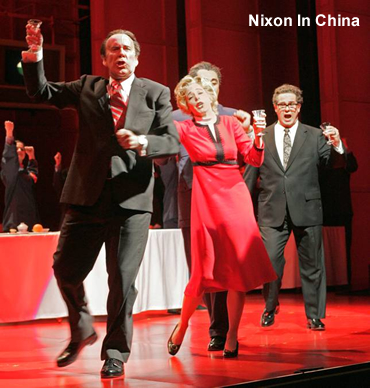 The opera, Adams explains, is neither comic nor, like The Huguenots or The Sicilian Vespers, historical, though it contains elements of both genres; rather, it is heroic and mythic. “The myths of our time,” he told the audience when The Chairman Dances was first performed on 31 January 1986 by the Milwaukee Symphony under Lukas Foss, “are not Cupid and Psyche or Orpheus or Ulysses, but characters like Mao and Nixon.”
The opera, Adams explains, is neither comic nor, like The Huguenots or The Sicilian Vespers, historical, though it contains elements of both genres; rather, it is heroic and mythic. “The myths of our time,” he told the audience when The Chairman Dances was first performed on 31 January 1986 by the Milwaukee Symphony under Lukas Foss, “are not Cupid and Psyche or Orpheus or Ulysses, but characters like Mao and Nixon.”
Nixon in China is set in three days of President Nixon’s visit to Beijing in February 1972, one act for each day. The single scene of the third act takes place in the Great Hall of the People, where there is yet another exhausting banquet, this one hosted by the Americans.
Here is the situation as described in a preface to the score of The Chairman Dances:
Madame Mao, alias Jiang Ching, has gatecrashed the Presidential banquet. She is seen standing first where she is most in the way of waiters. After a few minutes, she brings out a box of paper lanterns and hangs them around the hall, then strips down to a cheongsam, skin-tight from neck to ankle, and slit up to the hip. She signals the orchestra to play and begins to dance by herself. Mao is becoming excited. He steps down from his portrait on the wall and they begin to foxtrot together. They are back in Yenan, the night is warm, they are dancing to the gramophone…
Act Three, in which both reminiscing couples, the Nixons and the Maos, find themselves contrasting the vitality and optimism of youth with their present condition of age and power, is full of shadows; Jiang Ching’s and Mao’s foxtrot in the opera is therefore more melancholy than The Chairman Dances.
This is, uninhibitedly, a cabaret number, an entertainment, and a funny piece; as the Chairman and the former actress turned Deputy Head of the Cultural Revolution make their long trip back through time they turn into Fred and Ginger. The chugging music we first hear is associated with Mao; the seductive swaying-hips melody – La Valse humorously translated across immense distances – is Jiang Ching’s. You might imagine the piano part at the end being played by Richard Nixon.
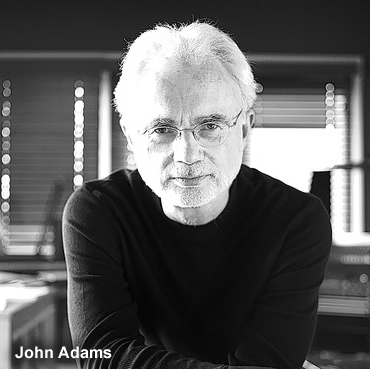 Christian Zeal and Activity is the central panel of a triptych called American Standard, written in 1973 under the influence of the radically stripped-down music of the English composer Cornelius Cardew and his Scratch Orchestra, and introduced under the composer’s direction by the San Francisco Conservatory New Music Ensemble on 23 March that year.
Christian Zeal and Activity is the central panel of a triptych called American Standard, written in 1973 under the influence of the radically stripped-down music of the English composer Cornelius Cardew and his Scratch Orchestra, and introduced under the composer’s direction by the San Francisco Conservatory New Music Ensemble on 23 March that year.
The “standards” are a march, a hymn, and a jazz ballad. I quote Adams: “The hymn tune’s harmonies, freed from their homophonic shackles, flaot in a kind of dream polyphony, only occasionally coming together to render a proper cadence.” In all three parts of American Standard the performers are invited to add relevant sonic “found objects.”
For this recording, a 1976 text-sound composition Sermon provides an interestingly nervous yet lyrical contract to the hymn tune’s serenity.
The most famous American fanfare is Hail to the Chief. Next comes Aaron Copland’s thumping huff and puff in honor of “the Common Man.” That was one of eighteen fanfares commissioned during World War II for the Cincinnati Symphony by its distinguished Music Director, Eugene Goossens.
Now Houston has outdone the Queen City: celebrating the sesquicentennial of the declaration of independence of the Republic of Texas, its Symphony has commissioned fanfares from more than twenty composers.
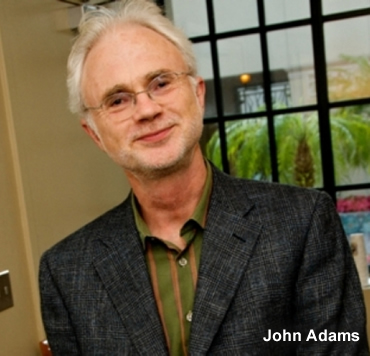 Tromba Iontana, introduced by Sergiu Comissiona on 4 April 1986, is John Adams’s contribution to the project. The title can be translated as Distant Trumpet or Trumpet in the Distance, though Adams points out that really it ought to be Trombe Iontane since there are two solo trumpets in stereo placement at the back corners of the stage. Most fanfares are brilliant, even aggressive (etymologists disagree whether the word is onomatopoetic or actually connected with the verbal family that gives us fanfaronade, meaning blustering and bragging behavior), but Tromba Iontana is, in Adams’s own description, “incredibly quiet, slowly moving, mysterious, almost ethereal.”
Tromba Iontana, introduced by Sergiu Comissiona on 4 April 1986, is John Adams’s contribution to the project. The title can be translated as Distant Trumpet or Trumpet in the Distance, though Adams points out that really it ought to be Trombe Iontane since there are two solo trumpets in stereo placement at the back corners of the stage. Most fanfares are brilliant, even aggressive (etymologists disagree whether the word is onomatopoetic or actually connected with the verbal family that gives us fanfaronade, meaning blustering and bragging behavior), but Tromba Iontana is, in Adams’s own description, “incredibly quiet, slowly moving, mysterious, almost ethereal.”
To think of Tromba Iontana as a remote cousin to Ives’s The Unanswered Question is not totally far-fetched.
By contrast, Short Ride in a Fast Machine is a joyfully exuberant piece, brilliantly scored for a large orchestra including two synthesizers. Commissioned for the opening concert of the Great Woods Festival in Mansfield, Massachusetts, it was first played on that occasion, 13 June 1986, by the Pittsburgh Symphony under Michael Tilson Thomas. The steady marking of a beat is typical of Adams’s music.
Tromba Iontana begins with a glockenspiel quietly marking the quarters, while piano, harp, flutes, and piccolos add a tinkling clockwork of eighth notes.
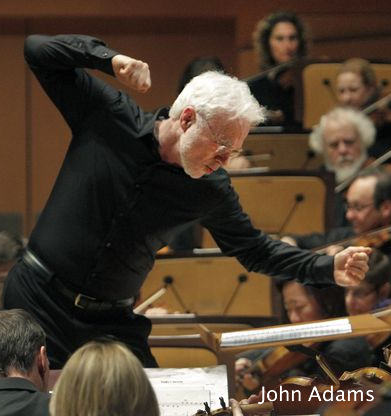 Short Ride begins with a similar marking of quarters (woodblock, soon joined by the four trumpets) and eighths (clarinets and synthesizers), but the woodblock is fortissimo and the other instruments play forte.
Short Ride begins with a similar marking of quarters (woodblock, soon joined by the four trumpets) and eighths (clarinets and synthesizers), but the woodblock is fortissimo and the other instruments play forte.
Adams describes the woodblock’s persistence as “almost sadistic” and thinks of the rest of the orchestra as running the gauntlet through that rhythmic tunnel.
About the title: “You know how it is when someone asks you to ride in a terrific sports car, and then you wish you hadn’t?” It is, in any event, a wonderful opening music for a new American outdoor festival.
John Adams likes referential titles, and if they are punning, so much the better (Wavemaker, Phrygian Gates, Shaker Loops, Harmonium, Harmonielehre, etc.). Common Tones in Simple Time first of all means what it says: The notes most of the time form triads, often called common chords, or equally straightforward and familiar harmonic constructions, and the meter is 4/4 or 2/2 all the way. Harmony yields another meaning for common tones.
A handy way to modulate from one key to another is to find a chord containing notes belonging both to the key you want to leave and the one you want to get to. These notes that allow you to use this chord as a pivot are called common tones. This is important because modulation from key to key is essential to what makes Common Tones in Simple Time go.
Not least, by immediately laying “common” and “simple” on the table, Adams both announces on aesthetic intention and moves one jump ahead of those critics to whom exoteric music is as the red rag to the bull.
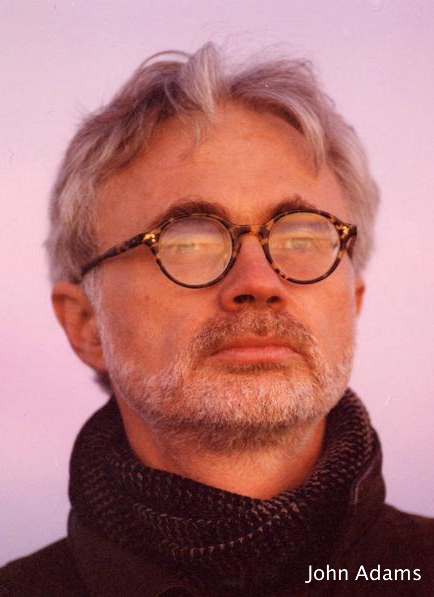 Common Tones in Simple Time, completed on 3 January 1980, was first played by the San Francisco Conservatory of Music Orchestra with Adams conducting on 30 January 1980.
Common Tones in Simple Time, completed on 3 January 1980, was first played by the San Francisco Conservatory of Music Orchestra with Adams conducting on 30 January 1980.
After hearing the piece several times, Adams withdrew it “for accoustical revisions,” and the work, which is dedicated “to my friend and teacher, Leon Kirchner,” was reintroduced in November 1986 by the San Francisco Symphony under Edo de Waart.
Tromba Iontana, Short Ride in a Fast Machine, The Chairman Dances, and Common Tones in Simple Time, though divergent in musical character, are all examples of the style now generally called minimalism. Its features are repetition, steady beat, and perhaps most crucially, a harmonic language with an emphasis on consonance unlike anything we have had in Western art music in the last five hundred years.
Some find it delightful, some maddening. Adams, not a simple artist and by no means a simple-minded one, subscribes to this aesthetic claim by the composer and theorist Fred Lerdahl: “The best music utilizes the full potential of our cognitive resources.” [Lerdahl cites Indian raga, Japanese koto, jazz, and most Western art music as good examples, Balinese gamelan and rock as musics that fail in this respect.]
Adams also described himself some years ago as a minimalist who was bored with minimalism. His concern has been to invent music that is at once familiar and subtle, and, for all of their familiar minimalist features, Shaker Loops, Harmonium, Grand Pianola Music, and Harmonielehre are full of surprises, always enchanting in the glow and gleam of their sonority, and bursting with the energy generated by their harmonic movement.
 I would say the same of Common Tones in Simple Time. It was the first piece by John Adams I ever heard (at its premiere).
I would say the same of Common Tones in Simple Time. It was the first piece by John Adams I ever heard (at its premiere).
It delighted me then, not least because the voice was so distinct from the already familiar voices of Riley, Young, Reich, and Glass (some of which I liked much more than others). It has been a delicious pleasure to return to it after an interval, to be dazzled again by the lustre of its sound, enchanted by the purr of its engine, startled by those powerful lifts into a new harmony (startled no less for anticipating them), and happy in its deep calm.
Common Tones in Simple Time is Adams’s most extreme essay in minimalism: there really are no tunes. Adams thinks of it as “a pastorale with pulse,” and the experience of listening to it as flying or gliding over a landscape of gently changing colors and textures. Violins and violas establish the quick vibration of sixteenth notes and they are soon joined by two pianos which have the same material but are always one sixteenth note out of phase with ether other (at the given speed, this means they are about one-tenth of a second apart). Oboes, flutes, and crotales (tuned antique finger cymbals) are the first instruments to play long, sustained notes, appearing and disappearing so discreetly that one is not aware of their attacks and releases, but only of a line whose color and thickness is constantly changing.
The spice of dissonance is used with utmost delicacy, but given the “simplicity” of so much of the music, we come to hear it as a major melodic and harmonic event when two oboes or two trumpets sway back and forth between neighboring B and C. The swells of the smaller hills are discerned to be parts of larger ranges.
Finally, we seem to ascend to such a height that we lose sight of detail, lose even the sense of our speedy flight over the ground, until the landscape vanishes from our view altogether. [Michael Steinberg is Artistic Adviser of the San Francisco Symphony.]
JOHN ADAMS – THE CHAIRMAN DANCES – TRACK LISTING:
- The Chairman Dances (Foxtrot for Orchestra) [12:27]
- Christian Zeal and Activity [10:00]
- Tromba Iontana [4:11]
- Short Ride in a Fast Machine [4:13]
- Common Tones in Simple Time [20:37]
FINAL THOUGHTS:
I think that incredibly detailed and long liner note description of the recording says it all.
 Emily Sachs – President – Manka Music Group (A division of Manka Bros. Studios – The World’s Largest Media Company)
Emily Sachs – President – Manka Music Group (A division of Manka Bros. Studios – The World’s Largest Media Company)


